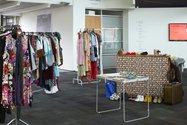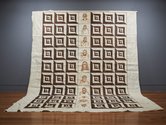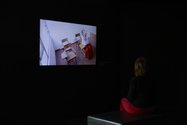John Hurrell – 27 November, 2020
DE-celerate examines the need to press the pause button, to slow down, reject the notion of progress and capitalism's enthusiasm for waste and mindless profit-making consumerism. These destructive tendencies have been underv attack for many decades, but lately they have been brought into sharper focus by the lethal impact of the pandemic and its exacerbation of unemployment.
Pakuranga
Étienne de France, Fiona Clark, Francisco Huichaqueo, Francisco Vidal, John Pule, Kaetaeta Watson, Kimsooja, Mariana Molteni, Maureen Lander, Nathan Pohio, Nicolas Molé, Richard Digoué, Sandra Monterroso, Simane Wenethem, Stevei Houkāmau, Visesio Siasau.
DE-celerate
Curated by Gabriela Salgado
5 September - 29 November 2020
Gabriela Salgado’s last show organised for Te Tuhi before she returned to London, DE-celerate examines the need to press the pause button, to slow down, reject the notion of progress and capitalism’s enthusiasm for waste and mindless profit-making consumerism. These destructive tendencies have been under attack for many decades, but lately they have been brought into sharper focus by the lethal impact of the pandemic and its exacerbation of unemployment.
Largely through the works of indigenous poets, sculptors and film-makers this wonderful exhibition looks at time cycles, focussed contemplation within concentrated moments, and inventive reusing of global and localised resources. Complex and varied, it celebrates many (hitherto marginal) voices advocating a pulling back from commercial fixations, embracing respect for nature, weather and their essential roles in our collective well-being.
Kimsooja is a South Korean artist based in New York. Her A Needle Woman (a projected video in what was the Te Tuhi library) shows the artist from behind, standing motionless in the middle of a very crowded street, deliberately obstructing the wide stream of pedestrian traffic so they have to swerve around her. (It has coincidental similarities with Jeremy Leatinu’u, Public Observations 11, 2010, where he is sitting like a Buddha in a busy crowded South Auckland mall.)
Straight as a rod (a human obelisk), Kimsooja makes us examine the oncoming tide of approaching walkers, their faces peering—mostly uncomprehending—at the filming camera.
Nathan Pohio’s set of changing transparencies (Sfakia-day for night, two files for two monitors, 2018), utilise a film processing method of converting daylight imagery to night-time. Sliding frames horizontally compare the two, featuring Pohio’s shots of Crete coastlines, places where the artist’s great uncle fought (and was hidden by local people for two years) during WW2. The tonal contrast between day and night perhaps symbolically means fast and slow, energy and repose.
Fiona Clark’s sprawling pioneering The Waitara Project (ongoing in various iterations from the 1980s) is a process-oriented community work where secondhand objects and garments are bartered through a process of negotiation—to ensure appreciative new owners and avoid waste. (As a point of comparison: less like an op-shop store, Eve Armstrong’s related Trading Table performances, well known from over a decade ago, are less overtly community oriented in their scale, and more about the intricacies of finding agreement for a swap. Both are not obviously ‘art’ in their appearance—more the setting up of exchange systems.)
John Pule’s lovely little free handwritten booklet (Sadness Spirit, 2013) has 16 short poems that could be arranged in any sequence. Here is one example of his haikulike texts:
potassium
secreted
from my
lower lip
was enough
to clone
an angel
Its minimal phrasing is stunning; so intensely vivid and full of surprises.
Chilean artist Francisco Huichaqueo (from the Mapuche Nation) presents three remarkable elemental films, using a wide range of techniques from subtle overlaying and grey and blurry antiquing, to hot saturated colour that leaps out at you. They are like highly nuanced home movies, dealing with place, the cycles of nature such as weather and plant growth, and family history.
One (Kulkul Child, 2020) is a flickering b/w loop projected into the inside of Wahi (2020), a beautiful pale ceramic pot by Stevei Houkāmau. The other two are much longer and more physically immersive for the viewer.
IIwen, the earth sells of father (2013) is about maintaining a vegetable garden, the digging of the earth, planting of seeds, the yearly cycles, the impact of inclement weather, the pleasure of gorgeous flowers, farmyard animals, home and father-son relationships.
Spirit Women (2020) is a stunning look at five women shaman-poets working in Chile, Mexico and Bolivia, who speak in their ancestral tongues, are gifted performers, and who sometimes wear amazingly colourful costumes. Often set with water imagery, reflected in gently meandering rivers or waves hitting beaches, these super-articulate women (through their dreamlike imagery) hit out at desecration of natural resources, the suffocating imposition of colonial languages, and the woeful inaction of political leaders in the face of the virus.
Maureen Lander and Kaetaeta Watson’s wall sculpture of twelve inventively woven garlands (Baau and Pare, 2020) explores cyclic chronologies, as if twelve consecutive months continually reoccurring. The two artists are amazingly inventive within the chosen limitations of the simple circular motif, incorporating all sorts of unexpected environmental materials, found during beeach walks.
Visesio Siasau’s NGATU ‘o VAVANGA ‘ATALOA, 2020 is a piece of ngatu (Tongan tapa cloth) made collaboratively with Serene Tay and Saimone Fonohema, using hiapo bark. The central column is unusual with its descending frames of stencilled figurative images—faces wearing Covid-masks—subtly hinting at anxiety about the availability of future vaccines.
Nicolas Molé and Mariana Molteri’s ‘voting booth’ of transparent flower-motiffed muslin (Insulatus, 2020)—with its table of four-sided videos with trapped inhabitants, and another four on the walls, all of Covid-masked jostling /dancing men (Richard Digoué and Simane Wenethem) and plants—seems to shout that ecological and Covid planetary solutions rely on responsible democratic consensus.
Another related work, Étienne de France’s The Green Vessel, 2020, features video and transparency of a wall-less house on a grassy island (built on a hidden constructed raft) floating on a mist-shrouded river. A symbol perhaps of the planet itself, its vulnerability and need for stability
Sandra Monterroso’s performance video (Breath of the Spirit, 2016) shows the artist moving around a classroom, breathing into and out of a large paper bag on which is written: ‘Racism is a colonial wound that can be healed’. The bag contracts and swells as she huffs, puffs, wheezes and blows while breathing through it. The aim seems to be to create a kind of filter, attempting to purify the noxious aether in the room.
Humans Go Home, 2020, Francisco Vidal’s gridded wall of 66 black-lined drawings—made during lockdown in Lisbon—reveals an artist with an elegant style akin to that found in many graphic novels. Multiple textual ‘erasures’ though—and overlapping forms— make it very different. He mingles portraits of artists he admires with social protest, images of indignation and deconstructed ambivalence. Copies of these drawings are available for free from the gallery office, undermining conventional art-commercial mores and encouraging the contemplative ethos of this show.
John Hurrell

















 Two Rooms presents a program of residencies and projects
Two Rooms presents a program of residencies and projects Advertising in this column
Advertising in this column



This Discussion has 0 comments.
Comment
Participate
Register to Participate.
Sign in
Sign in to an existing account.